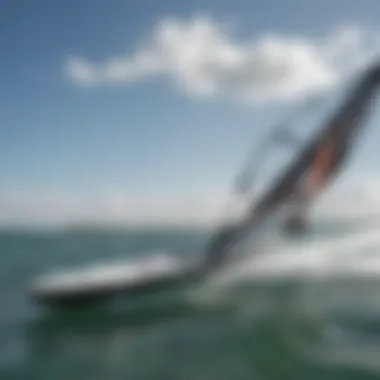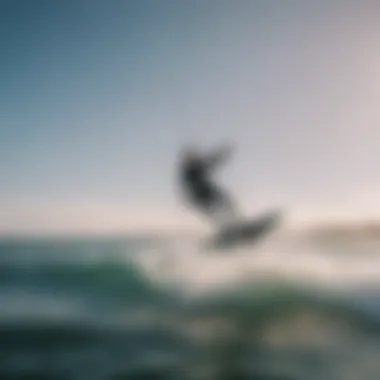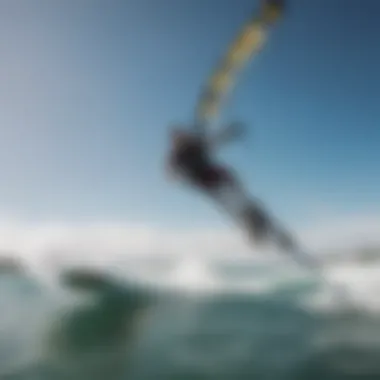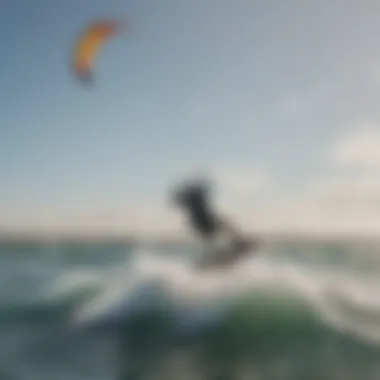Exploring Small Hydrofoils: Revolutionizing Kitesurfing


Intro
The integration of small hydrofoils in kitesurfing represents a significant evolution in the sport. Their function goes beyond traditional riding styles, offering new dimensions in performance and experience. As we dive into the exploration of this innovative advancement, it is essential to understand both the equipment and its practical applications.
In this section, we will not only analyze the equipment involved but also shed light on its implications for the future of kitesurfing. Small hydrofoils create a unique opportunity for riders to navigate through water with decreased resistance, enhancing speed and agility. That said, understanding how they function alongside kites, boards, and accessories is vital to fully appreciate their impact.
Equipment Reviews
To explore the full potential of small hydrofoils, we need a deep understanding of all related equipment. This section reviews various kites, boards, and accessories that work in conjunction with hydrofoils.
Kites
The kite is the primary tool in kitesurfing. Newer kite models come with advanced features to amplify performance when using small hydrofoils. These kites are designed to provide lift and control, optimizing the rider’s experience at higher speeds.
Consider kites with the following aspects:
- Shapes: Delta and flat kites tend to perform well with hydrofoils due to their stability.
- Sizes: Adjusting kite size can optimize power and control depending on the wind and rider skills.
- Materials: Lightweight materials improve responsiveness and help maintain durability.
Some notable brands offering noteworthy kites for hydrofoil kiting include Naish, North Kiteboarding, and Slingshot.
Boards
The choice of a kiteboard can greatly affect your hydrofoil riding. Twin-tips and directional boards serve different styles of riding. When engaging with hydrofoils, specialized boards are more suited, designed with a focus on lift and speed.
- Twin-tips: These boards are versatile and great for beginners who use hydrofoils. Their symmetrical shape helps balance.
- Directional Boards: These can be beneficial for experienced riders looking to ride waves while hydrofoiling, providing improved efficiency.
As for construction materials, lightweight composites ensure agility while still offering strength against the forces faced while kiting.
Accessories
Proper accessories play a crucial role in enhancing safety and performance.% Important accessories to consider include:
- Harnesses: A comfortable harness distributes tensions across your body and allows for greater freedom of movement.
- Lines: Strong, lightweight lines contribute to the kite's responsive handling.
- Launch Pumps: Efficient pumps ensure that your spas and accessory elements are functional.
- Safety Gear: High-quality life jackets and helmets can prevent injuries.
All of these factors combined amplify both safety and performance while utilizing small hydrofoils.
Travel Destinations
For riders wanting to fully appreciate small hydrofoils in different settings, knowing the best travel destinations is essential. You will find spots that cater specifically to kitesurfing enthusiasts and the unique preferences they bear. Discussions on enthusiastic locales will be covered in the following sections.
Techniques and Tutorials
In kitesurfing, skills are everything. Comprehensive guidelines will outline beginning steps, emphasizing maneuverability and control when using hydrofoils.
Safety Guidelines
Safety is critical when exploring new equipment in kitesurfing. Monitoring various conditions and adhering to emergency protocols can prevent accidents.
With these considerations in mind, we will delve into the exciting learning opportunities and crucial terrains awaiting adventurers in the terminal of small hydrofoils. This exploration extends further into actual applications and field studies, showing a world where traditional methods collide intriguingly with modern adaptations.
Prelims to Small Hydrofoils
The advent of small hydrofoils marks a significant change in the world of kitesurfing and alcha year-round enthusiasts. These specialized devices offer a unique approach to gliding through waters, transforming how kitesurfers experience speed and agility on the waves. Hydrofoils have evolved to become a critical part of modern kitesurfing technology. Thus, understanding their foundations is vital for anyone looking to maximize their experience in the sport.
Definition and Characteristics
Small hydrofoils are underwater wings attached to a board that lift the rider above the surface of the water when a certain speed is reached. This lift allows kitesurfers to achieve better speeds and reduce drag significantly, providing a smoother ride. Some characteristics of small hydrofoils include:
(1) Minimal drag: They offer efficient designs reduce water resistance, thus enhancing performance.
(2) Versatility: Hydrofoils can be used in various waterways and conditions, making them suitable for a diverse array of sports, not just kitesurfing.
(3) Easy maintenance: Their design favors durability, making them easier to keep in optimal condition.
These key traits contribute to a burgeoning interest in hydrofoiling, particularly among kitesurfing communities. Understanding their behavior on water is paramount for optimal utilization in the sport.


The Evolution of Hydrofoil Technology
The journey of hydrofoil technology has characterized the innovation across water sports. Initially developed for ocean racing in the early 1900s, the design went through stages of refinement driven by various needs within the market. Engineers adapted the shape, size, and material based on performance requirements and environmental challenges.
Significant developments started appearing in the 2000s as manufacturers began to focus more on enhancing user experience. The introduction of lighter materials such as carbon fiber made hydrofoils simpler to handle but more powerful. This enabled both accessibility for newer users and better performance for seasoned athletes.
As the technology progressed, manufacturing processes continued to advance, leading to specialized custom designs fitting individual kitesurfers' preferences and styles.
The momentous introduction of small hydrofoils into conventional kitesurfing created unprecedented growth in use cases. Competitions now recognize the potential of registered athletes adopting hydrofoils to enhance their chances, further integrating this technology within mainstream practices.
In summary, the essence and evolution surrounding small hydrofoils carve out new opportunities in kitesurfing. Adopting this technology can lead to improved control, speed, and overall joy on the water. That is why understanding their description, characteristics, and technological evolution is key for kitesurfers of all types.
Understanding the Mechanics of Hydrofoils
Understanding the mechanics of hydrofoils is critical in maximizing their potential in kitesurfing. This exploration delves into the principles that enable hydrofoils to lift surfboards above the water surface, thereby enhancing performance. By comprehending the mechanisms at play, kitesurfers can make informed decisions about equipment selection and usage, which can lead to better efficiency and enjoyment on the water.
Lift Generation Principles
Lift generation in hydrofoils is essential for achieving flight. The main principle is Bernoulli's principle, which states that an increase in the speed of air over a surface results in a decrease in pressure. When a hydrofoil moves through water, its shape and angle affect this airflow, creating lift.
Factors that influence lift generation include:
- Angle of attack: The angle between the hydrofoil and the direction of the oncoming water. A higher angle creates more lift up to a point.
- Speed: The quicker the hydrofoil moves through the water, the more lift it can potentially generate.
- Foil shape: A thicker and longer hydrofoil generally provides better lift capabilities.
Kitesurfers must understand these factors to optimize their rides. Choosing the right angle of attack can mean the difference between soaring above the waves and struggling with the board.
Drag Reduction Strategies
Drag reduction is just as important as lift generation. To achieve effective hydrofoil performance, it holds substantial significance in how kitesurfers navigate through different water conditions. Reducing drag leads to greater speed and enhanced maneuverability.
Primary drag reduction strategies include:
- Hydrofoil design: Streamlined shapes and proper material choices contribute to minimizing drag. Engineers focus on creating hydrofoils that can slice through water with ease.
- Reducing surface area: Smaller foot print on the watr can limit resistance, allowing for smoother motions while gliding.
- Controlled movement: Minimizing excessive body movements can help maintain speed and reduce lift-induced drag.
"The relationship between lift generation and drag reduction is a balancing act that every kitesurfer must learn to navigate for optimum performance."
Applications of Small Hydrofoils in Kitesurfing
The integration of small hydrofoils within kitesurfing brings several applications that reshape how enthusiasts engage with the sport. Understanding these applications helps to illustrate not only the versatility of the equipment but also the ways it enhances performance. With various uses ranging from recreational enjoyment to competitive advantages, small hydrofoils can optimize the experience for several kinds of kitesurfers. This section dissects key applications — recreational use, competitive edge in racing, and freestyle maneuvers with hydrofoil tricks — highlighting each one's relevance.
Recreational Use
Small hydrofoils in kitesurfing greatly elevate the recreational experience. They allow riders to glide smoothly over the water with reduced drag. This glide offers less fatigue over long sessions, enabling kitesurfers to explore more area and enjoy longer rides. The experience becomes more approachable, as users can easily find their rhythm.
Many riders, new to the sport, find that small hydrofoils allow them to maintain stability. This stability becomes essential, particularly in gusty conditions. Being able to feel connected with the water creates a sense of confidence. Additionally, the learning curve with small hydrofoils is relatively less steep compared to larger ones, enabling newer kitesurfers to quickly grasp their handling.
Hydrofoil equipment is often compact and easier to manage, making it suitable for various conditions and different body weights. Thus, localized surfing can become quicker and effortless. This sense of freedom grows the recreational community, bridging gaps among varying ability levels in kitesurfing.
Competitive Edge in Racing
The world of kitesurfing races presents a realm where small hydrofoils shine. With an essential focus on speed and aerodynamic efficiency, hydrofoils provide an advantage to competitors. Their unique design minimizes drag and allows for lift at high speeds. As riders become accustomed to flying above the water, they can achieve new performance heights in races or regattas.
Advantages such as shorter finishing times often result in competitive environments. The leagues and competitions that feature hydrofoiled kitesurf models often draw significant attention due to their thrilling potential. With improving technology, materials and buoyancy characteristics come newer, dynamic racing formats. This will motivate even casual participants to join competitive events.
Many experienced athletes consider hydrofoils as essential components to their racing strategy. Their functional design promotes speed over spontaneity, allowing them to implement disciplined approaches to handling. Overall, small hydroFOlis significantly boost kitesurfing racing outcomes, transforming expectations round>
Freestyle Maneuvers and Hydrofoil Tricks
Making tricks and freestyle moves a substantial hype among kitesurfers, small hydrofoils elevate mobility and performance during such maneuvers. By facilitating aerial maneuvers above the water surface, these designs let riders attempt diverse tricks with serious sophistication. Controllable lift shifts the balance, giving riders extensible time for spins, flips, and outstanding combos.


Important considerations exist for riders when performing tricks. Using small hydrofoils can feel entirely different from traditional boards. Athletes need to mentally and physically adapt to such transitions, ensuring correct technique in executing moves for success. Smaller resource offers fits together into stylish mast and wing combinations, making it sleek and designed. Furthermore, hydrofoil tricks often require an adjustment in timing and coordination due to the unique ride quality brought forth by the foils.
Kitesurfers value seeing innovation brushed into the sport. The interplay of new tricks displays significant character and growth to enthusiasts wanting to push their limits. In competitions, skills with small hydrofoils easily make great headlines or social media-sharing transformations that amplify overall kitesurfing scenes.
Engaging in freestyle maneuvers yields a symbiosis with the craft of kitesurfing, aiding kitesurfers to deep-dive into the extraordinary moment together.
The Benefits of Small Hydrofoils
Small hydrofoils offer numerous advantages that revolutionize kitesurfing. They are not merely an add-on to the surfing world but an evolution in how enthusiasts interact with water, wind, and sport. Understanding these benefits can enhance user experience and performance immensely.
Enhanced Speed and Efficiency
One of the most compelling features of small hydrofoils is their ability to enhance speed. The design minimizes drag, allowing riders to achieve greater velocities with less exertion compared to traditional setups. This means you can sail faster while maintaining less energy consumption, which is particularly beneficial for long distances.
Hydrofoils lift the rider above the water's surface after reaching a specific speed. The user moves smoothly across the water, reducing wake and turbulence, therefore allowing for accelerated travel. The enhanced efficiency during navigation can make longer sessions more enjoyable and less tiring.
It’s important to note that conditions like wind strength and water surface significantly affect the overall speed. Riders can achieve almost planing speeds on flat water, approaching those seen in windsurfing without the considerable equipment burden.
Furthermore, in various weather conditions, small hydrofoils allow a kitesurfer to stay aloft and take full advantage of available wind. This capability translates to more fluids and harmonious rides without the usual struggles associated with rough waters.
Improved Maneuverability
Maneuverability is another crucial benefit granted by small hydrofoils. With less water dragging at the board, kitesurfers experience a greater range of motion. Turns can be executed more smoothly and swiftly. This aspect alone can elevate the experience for both rookie and seasoned kitesurfers.
The design of hydrofoils provides a unique dynamic, where the rider can shift weight effectively to maintain control during high-speed maneuvers or trick executions. Adjusting balance requires practice, but once mastered, it opens a realm of possibilities in creating exciting tricks and fluid rolling movements.
Moreover, because hydrofoils sit higher above the waves, they are less likely to be influenced by typical wave patterns that would limit conventional board movement. Kitesurfers can directly navigate obstacles and poorly navigated waters without any performance lapse.
Small hydrofoils enable a fluidity that transforms the riding experience.
In summary, the adoption of small hydrofoils cannot be underestimated. Emphasizing speed efficacy and maneuverability is vital to revealing their full potential. As riders and athletes increasingly discover these benefits, it becomes clear that small hydrofoils may redefine exploration and enjoyment in kitesurfing.
Challenges and Limitations of Small Hydrofoils
The use of small hydrofoils in kitesurfing brings numerous opportunities, but it does not come without its share of challenges and limitations. Understanding these aspects is crucial for anyone considering this technology, whether for casual riding or competitive performance. Addressing these concerns can lead to better design improvements, user satisfaction, and ultimately, safer and more enjoyable experiences on the water.
Technical Challenges
The technical challenges related to small hydrofoils involve the complexity of the engineering aspects and their applications. A critical issue lies in the balance between lift and drag. While hydrofoils are designed to generate lift effectively, inefficient design or incorrect angles can increase drag, negatively impacting performance. Moreover, the construction of small hydrofoils requires knowledge of aerodynamics and hydrodynamics, areas that often involve extensive testing and refinement.
Performance can also be compromised by material choices. Hydrfoils must withstand both water resistance and significant aerial forces. Choosing materials that are both lightweight and durable is essential, yet achieving this balance poses engineering challenges. Similarly, small hydrofoils must be meticulously engineered to handle variations in the kitesurfing environment, such as shifts in wind speed or water conditions.
The technological barrier does not only affect hydrofoil manufacturers. End users can find themselves frustrated by issues such as instability and difficult control. Novice kite surfers might face additional challenges while trying to master these high-skill setups.
User Experience Concerns
User experience is a pivotal consideration for those looking to embrace small hydrofoils in kitesurfing. Feedback from riders indicates a learning curve associated with maneuvering these craft. Unlike traditional kitesurfing boards, the nuances of controlling a hydrofoil can change one’s approach to riding. New users, in particular, may struggle initially with balancing and stabilization. The experience can be unenjoyable if riders do not feel comfortable yet.
Moreover, small hydrofoils may exacerbate safety concerns. The increased speed and lift can lead to unexpected challenges when the rider is suddenly airborne or of balance. The risk of falls and subsequent injuries can detter potential users from attempting the sport. Riders must communicate and receive guidance on best practices to referee safe operation in various conditions.
Lastly, accessibility also plays a role in user experiences. Small hydrofoils often demand tailored kites and other gear, potentially increasing costs and discouraging casual racers from making the leap.
These challenges highlight the disparity between potential and practical use of small hydrofoils in kitesurfing. Awareness and education will turn these obstacles into opportunities for growth and design advancement.
Future Trends in Hydrofoil Design
The landscape of hydrofoil design is advancing rapidly, represented by a fusion of engineering principals and innovative ideas. This section explores future trends crucial for enhancing the kitesurfing experience. Understanding these trends allow assess to advanced capabilities while addressing the evolving demands of water sports enthusiasts. It examines how new innovations could rewrite the operational limits of small hydrofoils.
Innovations in Material Science


Material science has significantly influenced the development of hydrofoils. This sector focuses on lighter, stronger materials which improve overall performance. High-strength carbon fiber and ultra-lightweight plastics have become standards. They provide rigidity without adding weight, allowing kitesurfers to achieve greater speeds and maneuverability.
Additionally, advancements in composite materials descendants enhance durability, increasing the lifespan of hydrofoils when exposed to harsh maritime environments. As these materials provide better hydrodynamic qualities, they lower drag and significantly enhance lift generation. Adhesive responses stimulated bonding and reduces moisture permeability, therefore contributing to a boost in performance.
Keeping sustainability in mind, eco-friendly materials are also gaining traction. Innovations in bio-composites represent a step toward integrating environmentally responsible practices in water sport devices.
Adaptive Flight Control Systems
Adaptive flight control systems represent a quantum leap in how kitesurfers interact with their equipment. These systems employ sensors and algorithms to dynamically adjust the hydrofoil’s performance in real-time. For instance, by analyzing data such as riding velocity and angle, the systems can modify foil angles to optimize lift while minimizing drag.
This technology ultimately increases user-friendliness, making hydrofoils accessible to newer riders. This translates to a more balanced experience on the water, irrespective of skill levels. Moreover, advanced flight control interfaces can offer insights about riding dynamics, allowing kitesurfers to refine their techniques based on analyses much similar to functionalities in flight simulators for pilots.
Recently, several commercial brands demonstrated these capabilities through special editions designed for beginners. They exhibit certain fail-safes programmed to diminish risks associated with hydrofoils. At this juncture, as technology converges, the adaption of comprehensive control system foils promises a possible future where safety and performance are not only enhanced but merged seamlessly.
The future of hydrofoil design is in materials innovation and adaptive systems, redefining what kitesurfing can be for all athletes.
Case Studies of Hydrofoil Kitesurfing
Understanding real-world examples of hydrofoil kitesurfing provides valuable insights into the application and impact of this innovative technology within the sport. These case studies illustrate not only how athletes utilize hydrofoils but also the tangible benefits that come from their use. By examining the experiences of notable athletes and the effects of hydrofoils on various competitions, we can draw conclusions about how hydrofoiling is shaping the future of kitesurfing.
Notable Athletes and Their Experiences
The experiences of top athletes in hydrofoiling can illuminate the gains in performance and enjoyment that come with this advancement in gear. Renowned kitesurfers like Alex Caizergues and Francesca Bagnato are pioneers in employing small hydrofoils, stating enhancements in overall speed and maneuverability.
- Alex Caizergues, for instance, has been a vocal advocate for hydrofoiling due to its ability to enable speed at lower wind conditions, allowing him to perform at its best regardless of the environment.
- Francesca Bagnato details how mastering tricks on hydrofoils gives her competitive advantage, marking her distinct style in competitions. She reveals the challenges faced during early attempts, such as balance and control, but emphasizes that such difficulties ultimately strengthen her skillset.
Through their narratives, we see how these athletes adapt to and push the boundaries of hydrofoil technology to enhance their performance.
Impact on Competitions
The introduction of small hydrofoils has transformed kitesurfing competitions. Their effects on racing can be described by several key observations:
- Increased Speed: Hydrofoils allow for higher speeds than conventional boards. Many races now feature hydrofoil-specific categories. The hull raises above the water surface, reducing drag and enabling kitesurfers to glide over choppy conditions more efficiently.
- New Strategies: Athletes must adjust their techniques and tactics. Mastering the maneuverability of hydrofoils is critical. This includes everything from turning radius to jumping height. Competitors leveraging these innovations often find themselves in advantageous positions during heats.
- Diverse Course Layouts: Race organizers are incorporating technical courses that present distinct challenges, suited for hydrofoiling attributes. Features like gates and technical turns bring excitement and demand precision from participants.
A striking change brought by this shift is the enthusiasm and engagement explosive in both the athlete community and spectator elements of sports events. As more competitors adopt hydrofoils, we may expect broader embrace of these units across various types of kitesurfing experiences.
Ending and Recommendations
The conclusion of this article emphasizes the transformative impact that small hydrofoils can have on kitesurfing. It has reshaped the interpretations of speed, maneuverability, and excitement within the sport. By articulating the pivotal pieces discussed in prior sections, this narrative is intended to present a holistic understanding of why adopting hydrofoils is advantageous and highlight factors to consider for kitesurfers.
Key insights revealed from examining this innovative technology include:
- Enhanced Performance: Hydrofoils allow kitesurfers to achieve remarkable speeds while utilizing less power from the kite.
- Adaptable Design Choices: The variety in hydrofoil shapes, sizes, and materials enables kitesurfers of all skill levels to find equipment that suits personal preferences and styling.
- User Engagement: Athletes learn to maneuver differently with hydrofoils which can lead to innovative tricks and enhance the overall experience of kitesurfing.
Embracing this technology involves time for adaptation and practice, but being on a foil does reward effort. Overall, small hydrofoils present both many benefits and challenges which need analysis.
Integration of this knowledge can shape the direction individuals take in the sport. As trends advance further in kitesurfing, optimizing used hardware while doubling down on personal skill development presents opportunity for improvement.
Summarizing Key Insights
Summation of the core elements reveals several important trends and considerations:
- Introducing Hydrofoils: The shift to smaller hydrofoils is grounded in the quest for heightened performance, granting kitesurfers a novel way to experience water riding.
- Competitive Landscape: Competitive kitesurfers are navigating towards hydrofoil technologies to lower drag and increase overall efficacy during events, which becomes a differentiator as more competitors adapt.
- Community Growth: As interest in hydrofoiling grows, new communities and resources for learning will emerge, supplying riders with enhanced learning opportunities tailored for hydrofoil kitesurfing.
The future of kitesurfing is intertwined with the evolution of hydrofoil technology, enhancing both recreational pleasure and performance metrics among varied levels of athletes.
Future Prospects for Kitesurfing and Hydrofoils
Looking forward, several prospects emerge that can influence both the sport and its equipment. Key trends include:
- Material Advancements: Continuous innovations in carbon fiber and other lightweight materials will positively affect both performance and longevity of hydrofoils.
- Smart Technology Integration: Adaptive systems could lead to smarter boards, capturing performance metrics and kite angles while tuning set-ups effectively.
- Sustainability Considerations: A rising number of consumers aligning with eco-friendly products suggests future options cann utilize materials that lessen ecological footprints while providing superior performance.
In summary, how athletes navigate these waters will dictate the evolution of kitesurfing amidst a promising future that welcomes abilities transitioning from conventional setups to hydrofoil technology.







